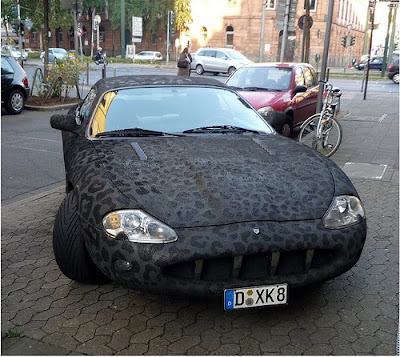
Wednesday, June 30, 2010
Jaguar XKR 75 2010
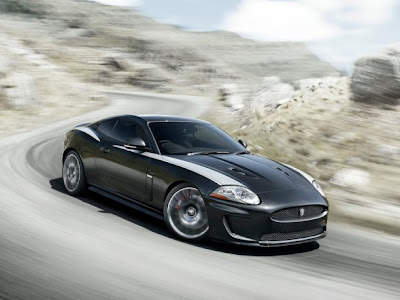
The uniqueness of exclusive features of the new XKR 75 include increased performance by recalibrating the engine and transmission details, more power to 530p (compared with 510 PS on XKR), not much at 655nm torque (625Nm at cons XKR). In Jaguar XKR 75 there is no torque converter upgraded to handle the increased torque, suspension system enhanced to improve the accuracy and agility, increase the spring and damper rates (spring 28 percent of the front springs are fixed at the rear 32 percent more rigid), new aluminum front, the engine and completely revised rear suspension for improved vertical camber stiffness (up 25 per cent), dynamic Adaptive Re-listening damper control software, reduce no. ride height (15mm front and 10mm rear). This Jaguar features Body Pack finished aerodynamic body color front splitter, rocker extensions and rear diffuser, and body colored rear spoiler and larger rear deck lid finisher.
Tuesday, June 29, 2010
2010 Tesla Roadster TAG Heuer
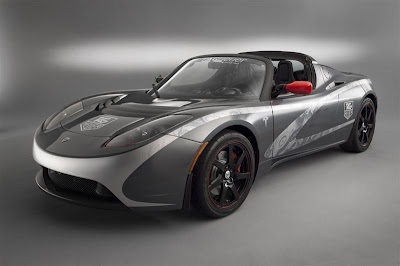
Renault Megane Trophy (2009)
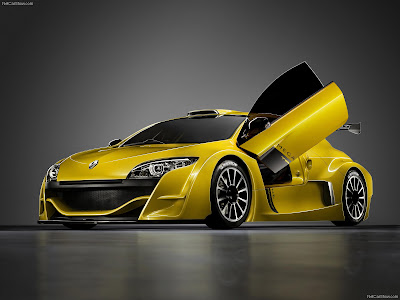
The new Renault Mégane Trophy features the same mechanicals as the current car, including an FIA-homologated sports-prototype tubular chassis, a mid-rear V6 3.5 24V engine.The most visible change concerns its new body design which takes its inspiration from the lines of New Mégane Coupe. Under the bonnet, a fresh look has also been taken at the Renault-Nissan Alliance's V6 3.5 24V powerplant which now delivers 360hp.A new inlet manifold, which is fed by roof-mounted air-ducts, has taken engine power from 330 to 360hp. The new car's reliability is as excellent as ever with rebuild intervals of every 5,500km. Combined with the aerodynamic gains, the extra power output of the V6 3.5 24V engine will enable new Renault Mégane Trophy to lap in times similar to those of a Porsche GT3.
TechArt Porsche Carrera GT
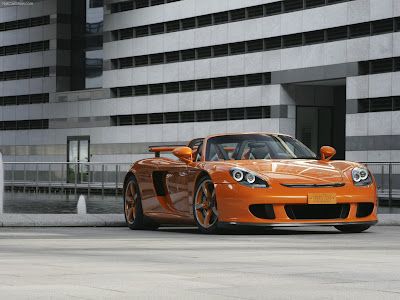


The TechArt designers have developed aerodynamically efficient custom-tailored body components made from exposed carbon fiber that serve as a visual contrast to the metallic-orange special paint.Both benefit not only the engine sound that escapes through the two production tailpipes; the modifications also increase maximum power output from 612 hp / 450 kW to some 635 hp / 467 kW.The low-reaching front spoiler reduces lift on the front axle at high speeds further and thus further optimizes directional stability.TechArt has also developed a three-piece gurney flap that serves as the aerodynamic counterpart in the rear.The center piece of the separation edge extends together with the pop-up rear wing and in combination with the fixed spoiler edges on the left and right produces additional downforce on the rear axle.
Bentley Continental Supersports Convertible
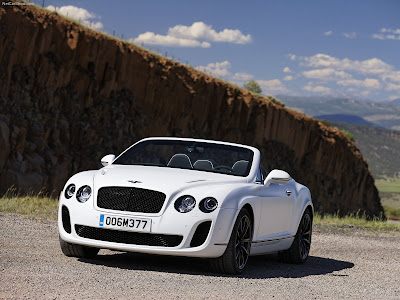


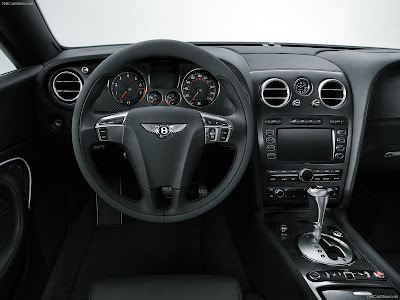
The new Supersports Convertible, with the same 630PS (621bhp/463kW) twin-turbocharged W12 engine, is the fastest, most potent drop-top Bentley has ever built, offering the ultimate Bentley driving experience in the world's most dramatic convertible.A highly focussed, pure Bentley driving experience
With 630PS (621bhp) and 800Nm (590lb ft) of torque from its pioneering FlexFuel engine and new 'Quickshift' transmission, the Bentley Continental Supersports Convertible is the fastest drop-top Bentley has ever built. It accelerates from 0-60mph in 3.9 seconds (0-100km/h in 4.2 seconds) and, conditions permitting, can continue onto a top speed of 202mph (325km/h).The Bentley Continental Supersports Convertible also shares its ride height with the GTC Speed, sitting 10mm (0.4in) lower at the front and 15mm (0.6in) lower at the rear than the standard GTC.The 9.5Jx20-inch forged alloy wheels, shared with the Supersports Coupé, offer a weight saving of 10kg (22lb) per car, reducing unsprung and rotating mass while the open 10-spoke design offers superior brake cooling. The rear wheels have a 25mm (1 inch) greater offset resulting in a 50mm (2 inches) increase in the rear track, further benefiting handling and stability.Eye-catching, black gloss Bentley-branded brake calipers act on the carbon ceramic brakes. Surrounding the brakes are the unique 20-inch, forged alloy wheels with Smoked Steel-finish which are exclusive to Supersports models. Large diameter tailpipe trims round out the car's purposeful stance when viewed from the rear. Beneath the bonnet Supersports badges grace the cover of the 630PS (621bhp) W12 engine.
ABT VW New Beetle Cabriolet


The ABT VW New Beetle Cabriolet including two types of back-silencers, an aluminium gear lever knob, aluminium pedals, stainless steel running boards, as well as a set of floormats displaying the Abt Sportsline logo. Additionally, a New Beetle owner can choose between 14 wheels, one of them being the brand-new Z5 wheel (8 x 18") presented on the IAA motor show.The 2.0-litre engine receives a power plus to ca. 105 kW (143 hp) thanks to capacity enhancement by 200 cubic centimetres, a customized Abt crankshaft, special pistons, Abt camschafts, a cylinder head modification, a mid-silencer, optimised air ducting as well as changes to the electronic engine management. Abt expertise in the ECU field ensures an increase in the 1.8-litre turbo-engine from 110 kW (150 hp) to 142 kW (193 hp). For the 1.9-litre TDI, Abt provides an increase from 66 kW (90 hp) to 85 kW (112 hp).A front grill, chrome fog headlamp frame, headlamp visor and the matching V-rims (7.5 x 17 inch) rounds off the New Beetle body kit from the House of Abt.A very special example of the New Beetle caused a sensation in German rallying: Together with natural gas supplier Thyssengas, Abt enters a Beetle in the German Rally Challenge series and the German Rally Championship. The highlight: The 230 hp model uses natural gas instead of traditional fuel.
2010 9ff SPEED 9
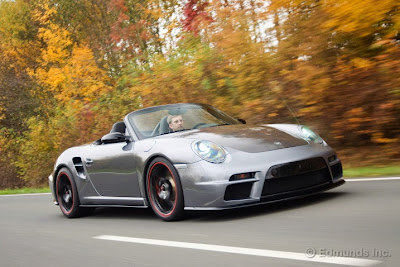
2011 Mercedes SLS AMG GT3

Need For Speed Carbon RX 7

High Horse Power Car
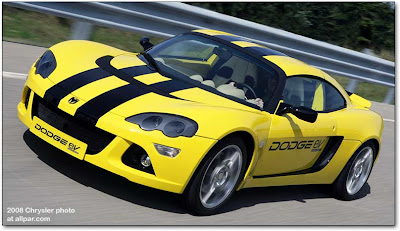

I.D.E.A KAZ

Monday, June 28, 2010
Citroen DS3 Racing (2011)





Citroën DS3 Racing is a special edition with a 100% sporting pedigree.The exclusive Citroën DS3 Racing will be limited to just 1000 production units.With integrated carbon-trimmed components and specialist motorsports equipment, Citroën DS3 Racing's tuned and turbo-charged 1.6-litre THP 150 engine develops 200hp - a power increase of almost 30% over the standard unit - with a torque increase of 15% from 240Nm to 275Nm.The Citroën DS3 front wheels get 4-piston racing callipers and special disc-brakes - with drilled discs at the rear.The new Citroën DS3 Racing edition inherits Citroën Racing's expertise in motorsport design to provide advanced technological and stylistic sporting prowess.Based on the existing DSport powered by the THP 150, production Citroën DS3 Racing editions will be finished in a special workshop and fitted with a parts kit developed according to Citroën Racing specifications.
Citroen REVOLTe


Citroën REVOLTe Concept also provides the option of CO2-free driving with the ability to run in all-electric ZEV (Zero Emission Vehicle) mode.At the very front of Citroën REVOLTe Concept, a backlit glass element is incorporated into the grille - this original feature highlights the chevrons above, subtly asserting the concept's identity as true Citroën.Citroën looking to the future by taking inspiration from its cool past. Where the 2CV was plain and neutral, REVOLTe is luxurious and colourful; where the 2CV was basic and simple, Citroën REVOLTe Concept is intelligent and technologically advanced and where the 2CV was slow and bouncy, REVOLTe is lively and spirited.Citroën REVOLTe is a visually-stunning low stance, Citroën REVOLTe Concept measures just 3.68m long, 1.73m wide and 1.35m tall.
New 2010 Gordon Murray T.25

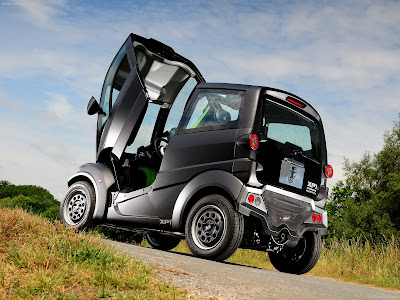

Gordon Murray Design's T.25 City Car will make its first public appearance at the Smith School's World Forum on Enterprise and the Environment in Oxford.A world leading 6 metre turning circle will help with urban manoeuvring and parking whilst its 1.3 metre width opens any opportunity for timed lane zones with 2 vehicles travelling and over taking in one lane.This reduces capital investment in the assembly plant by at least 80%.The ultra lightweight by design (approximately 550kg) means that:component life is increased. Reduced energy is required to power vehicle, giving rise to higher fuel efficiency (mpg/electric battery range).A competitive power to weight ratio is achieved.Six internal layout options with rear seat adjustment (adjustable within 20 seconds) sets new standards in small vehicle packaging - a long way in front of the Smart For 2 and the Toyota iQ.Occupant capacity of between 1 and 3 persons. Luggage capacity of between 160 litres and 720 litres.
Bugatti Veyron Centenaire
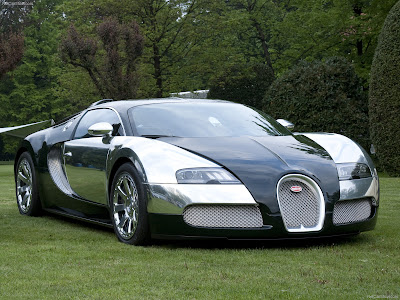
The Bugatti Veyron Centenaire is a very expensive and good looking car in the world .The Type 35 Grand Prix was by far the most successful racing model. The unmistakable radiator grille and eight-spoke aluminium wheels of the Type 35 have become defining features of the Bugatti automobile. In its day, the Grand Prix was also well ahead of its time in terms of engineering ingenuity.The Grand Prix's brake drums were integrally fitted into its lightweight aluminium wheels. Unfastening the central wheel nut allowed the wheel to be easily removed within a matter of seconds and the brake to be exposed. This was a crucial advantage at the pit stop.Supposedly called the Centenaire edition, reports suggest the special Veyron an increased power rating – word on the street has always been that the Veyron's quad-turbo W16 was always capable of more than the already astronomic 1000 horsepower rating it got – up to some 1350 horses, good enough to boost the top end up to 420 km/h (261 miles-per-hour) from the current benchmark of 400 km/h (253 mph). Special paint schemes and trim pieces will surely be part of the mix as well, but hitting the Willard Scott mark may prove enough to warrant a more substantial birthday gift if the rumors are to be believed.
Bugatti Galibier


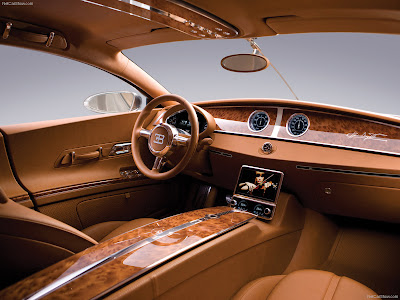
The Bugatti Galibier's design masters the challenge of uniting sportiness with the comfort and elegance of a modern four-door saloon. The basic architecture picks up on the torpedo-like character of the Type 35, which was already revived in the Bugatti Veyron, and reinterprets it.The Bugatti Galibier i16-cylinder,8-litre engine with twostage supercharging and features 64 valves, generating 1001 horsepower at 6000 rpm.The Bugatti Galibier engine special is that it was developed as a flex-fuel engine and can optional be run on ethanol. Four-wheel drive, specially developed ceramic brakes and a new suspension design enable the agile, always-sure handling of a saloon of this size. The engine draws on its 8-litre displacement to deliver a maximum torque of 1250 Newton-metres between 2200 and 5500 rpm. Apply the brakes at speeds above 200 km/h, and the rear wing acts as an airbrake, positioning itself at an angle of 113 degrees in less than 0.4 seconds, augmenting the Bugatti Veyron's already impressive stopping power. The airbrake increases negative lift at the rear of the car to 300 kg, enhancing the braking torque on the rear axle. At 400 km/h, emergency braking will bring the sports car to a complete halt in less than 10 seconds.This striking and unparalleled harmony between luxury and sportiness is complemented by alloy-coloured details in the form of the chromed Bugatti grill and door-mirrors, as well as polished wheel surfaces and roof-rails. All-black front lights, air intakes, filler caps and door-handles naturally heighten the stunning effect of the racing-blue brake callipers.
Bugatti Veyron Sang Noir

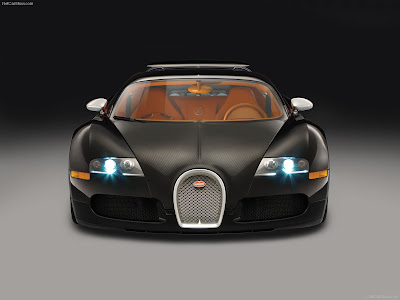

The Bugatti Veyron Sang Noir is a special edition, created for the true automotive connoisseur.Similar to its thoroughbred predecessor, the Type 57S Atlantic, the Bugatti Veyron Sang Noir exposes a raptor-like DNA that is reflected throughout the entire model history of the marque..The Bugatti Veyron Sang Noir is a special edition, created for the true automotive connoisseur.The 16-cylinder "W" configuration engine is fed by four turbochargers and features 64 valves, generating 1001 horsepower at 6000 rpm. The engine draws on its 8-litre displacement to deliver a maximum torque of 1250 Newton-metres between 2200 and 5500 rpm. Apply the brakes at speeds above 200 km/h, and the rear wing acts as an airbrake, positioning itself at an angle of 113 degrees in less than 0.4 seconds, augmenting the Bugatti Veyron's already impressive stopping power. The airbrake increases negative lift at the rear of the car to 300 kg, enhancing the braking torque on the rear axle. At 400 km/h, emergency braking will bring the sports car to a complete halt in less than 10 seconds.This striking and unparalleled harmony between luxury and sportiness is complemented by alloy-coloured details in the form of the chromed Bugatti grill and door-mirrors, as well as polished wheel surfaces and roof-rails. All-black front lights, air intakes, filler caps and door-handles naturally heighten the stunning effect of the racing-blue brake callipers.
Thursday, June 24, 2010
The Man’s Got Vision; Help Him Share It
I want you to help me get rid of some of my money. Seriously. The catch is this: To help me get rid of my money, you’ve got to be willing to part with some of yours. Don’t worry: This isn’t some Internet scam or pyramid scheme. It’s all legit. So, please, hear me out. Hear me all the way out. Let me explain.
I want you to donate money, even just a little, to Steven Boone. Boone is one of the authors of the blog Big Media Vandalism and a contributor to sites such as The House Next Door. In addition, he’s a “micro-budget filmmaker” who has made mostly “esoteric” shorts that can be found on Vimeo. (I recommend “Wolf City High and Low” and “Notes for a David Lynch Adaptation of Moonwalk” if you want a taste of Boone’s creativity.) Up to now, Boone has made his films using “borrowed, broken and public computers,” and that’s been fine. But as he approaches the creation of an ambitious film series he’s calling “The Best of Everything,” he figures he needs his own dependable equipment. And that’s where you (and I) come in. Please, keep reading.
Boone is attempting to raise $3,500 to purchase a computer (with editing software), a camera and a microphone. But here’s the deal: The deadline for donations is July 19, less than a month away, and if the full $3,500 isn’t in the pot, Boone isn’t taking a dime of it. That’s why even though I’ve already made my donation, my offering is effectively an empty gesture unless more people can chip in and help Boone reach the $3,500 mark. (As of publication, he’s got a long way to go.)
I hate empty gestures, but that’s not the reason I’m encouraging you to get involved. Rather, I’m asking you to donate because I believe in Boone’s project. On the following Kickstarter site, which allows you to donate using an existing Amazon account, you'll find a description of his “The Best of Everything” series as well as a teaser trailer for the first chapter.
Read the description. Watch the trailer. If you do both, I think you’ll be convinced to donate. And here’s why …
How many movies will you see this year that you know, even before you walk inside the theater, haven't been created as art whatsoever but as profit vehicles only? How many empty Hollywood films will you pay to see even though you know that chances are high you’ll walk out of the multiplex feeling empty? Can I tell you with certainty that Boone will make an awesome video series? No. I can’t. But this much is clear: the man has passion and a vision, and that’s something that cinephiles should support whenever we can.
Are you reading this at home? How many DVDs do you have on the shelf that you’ve never even watched? How many times have you walked away with two DVDs for movies you only kinda-sorta liked but added to your collection anyway because you found them in the $10 bargain bin?
I’m not asking you to spend money you don’t have. If money is tight, if you really can’t contribute, don’t. But most of us could probably skip Starbucks twice, and there’s $6 right there. Most of us could probably pass on the sequel to the blockbuster we weren’t crazy about the first time around, and that’s good for $10. And that’s not a lot, but it’s a lot better than nothing.
Still, if I may be so bold, I encourage you to donate $20 (or more, if you can). Sacrifice buying one of those DVDs you’ll never watch and instead contribute to the creation of something that you might really admire.
Full disclosure: I’ve traded a few friendly emails with Steven, but I don’t know him well. So, on the one hand I can’t necessarily vouch for him, but on the other hand I’m not here asking for a handout for a close personal friend.
So, watch the trailer below. Read the description of the project. See if it makes you feel inspired. Then donate, even if it’s a small amount. Even if it’s $1. Then, just as important, please spread the word.
There’s less than a month to go. I want Boone to have my donation. I need your help for that to happen.
Thanks for reading. Thanks for donating. Thanks for supporting a man with vision. We need more of them.

Steven Boone on "The Best of Everything":
"The Best of Everything" is my latest and most ambitious video essay, a ten-chapter series. I use the format to lampoon, poeticize and dissect my own struggle to find love, meaning and a purpose during the tumultuous past decade in New York City. This is the story of a blue collar working stiff who insisted on writing and chasing his addiction (movies) against all reason-- and even after I went homeless. In this video, you will hear cultural/social commentary you just can't get from The New Yorker or The Times, not only from myself but also the movie-mad folks down here in the streets with me. I'm coming from a place Shohei Imamura called "the lower half of society"-- or, as I call it, the best seat in the house.
Tuesday, June 22, 2010
Beyond the Game: The Two Escobars
If one of the things that June 17, 1994 reminded us is that we can’t watch professional athletes on the playing field and know what kind of people they are, The Two Escobars offers the equally important reminder that no amount of media coverage can provide us with a clear understanding of what these athletes are going through. The latest release in ESPN Films’ “30 for 30” series opens with shots of the Colombian soccer team looking less than enthusiastic as they walk onto the pitch in front of a passionate capacity crowd at the Rose Bowl for a crucial match against the United States in the 1994 World Cup. To most, the Colombians look as if they’re feeling the pressure of having been upset by Romania in their opening game, and they are. They also look as if they’re suffering an unfamiliar lack of confidence, and that’s probably right, too. But there’s something else there, something that’s more difficult to detect because it’s not something most of us expect to find at a soccer game. That something else is fear, real fear – the fear of losing something much more significant than a game. To spot that fear, you have to be able to crawl inside the minds of the Colombian players, to understand where they come from, what they’re playing for and what they stand to lose. To see that fear, you have to see beyond sports. That’s what The Two Escobars does so well.
Directed by Jeff and Michael Zimbalist, The Two Escobars is less a sports documentary than a gritty South American crime saga. It’s The Godfather by way of Che Guevara as written by Tom Clancy and adapted for the screen by David Simon. It’s packed with assassinations, government corruption, drug trafficking, money laundering, militia wars, kidnapping and terrorism. There’s enough here for a miniseries. Instead it’s a taut 100-minute powerhouse overflowing with so much compelling archival footage that you figure the Zimbalists grew up clipping newspaper articles and storing them in shoeboxes underneath their beds, just waiting for their chance to tell this story. The impressive density and complexity of The Two Escobars is occasionally overwhelming, particularly in the early going when we’re assaulted with overlapping narrative voices (in Spanish, with English subtitles) that have a habit of referring to names we’re still trying to associate with faces. But the longer we watch, the more it makes sense, both logically and emotionally. Watching this film is a little like staring at Picasso’s Guernica: The whole is impossible to comprehend at once, so instead we understand it in pieces until the big picture paints itself in our minds as some kind of subconscious panorama that we could never quite describe in words.
The Escobars of the film’s title are Andres, the standout sweeper and national-team captain, and Pablo, the billionaire head of the Medellin cartel. Unlike the Zimbalists, these men were unrelated. But that doesn’t mean they weren’t linked. Andres was a star on the club soccer team owned by Pablo – the very team Pablo used as a front to launder millions he earned from his cocaine enterprise, and the team that Pablo made more successful than it otherwise would have been by bribing and threatening referees, and sometimes backing up those threats. When Pablo was on the run from the Colombian government, he carried a radio so that he could listen to the on-field feats of Andres and the rest of the national team. When Pablo was cozily behind bars at a prison he’d constructed, Andres was among the professional soccer players invited to come inside the gates to play exhibitions for their No. 1 fan. It was Pablo who paid for the soccer fields in poorer-than-poor neighborhoods. It was Pablo who made the drug-funded sport – “Narco-soccer,” they called it – such a lucrative endeavor in that impoverished country that Andres and his fellow Colombians developed into one of the best soccer squads in the world. It was Pablo who helped create Colombia’s worldwide reputation for drugs, murder and terrorism, which Andres and his teammates felt could only be rewritten by a shining performance on the World Cup stage. And when Andres was murdered a few days after scoring a tragic own-goal that eliminated his team from the World Cup, it was Pablo who entered people’s minds – some blaming him for fostering the criminal underworld responsible for Andres’ death, others professing that if soccer-fan Pablo had still been alive, Andres would have been, too.
To call Pablo Escobar a fascinating figure is to sell him short. He was the kingpin of a ruthless army of organized crime, which should have made him universally detestable, but he wasn’t. To many in Colombia he was a savior, a real-life Robin Hood, not because he won minds, convincing impoverished Colombians that their government was corrupt and needed to be overthrown, but because he did things the government couldn’t afford to do. For people who had been living in a garbage dump, he built homes. For communities with nothing, he gave them soccer fields and equipment. While he threatened those in Colombia who had, he gave to those who had not. They loved him for it. The Zimbalists document this creepy goodwill with the same clarity they apply to the carnage and destruction that resulted from Pablo’s wrath. It helps that several of Pablo’s close associates who are interviewed in this picture are just as detailed when describing Pablo’s calculated generosity as when describing his viciousness. But it’s the images that tell the story. Footage of assaults, shootings, explosions and corpses burn into the mind. This is the most graphic film in the “30 for 30” series thus far, and it will remain that way. Its gruesomeness is tough to top.
That’s why what I’m about to say feels so strange: In stretches, The Two Escobars is magnificently beautiful, too. If you’ve ever doubted the allure of soccer, you won’t after seeing highlights of the Colombian team (accompanied by Michael Furjanic’s lively score), which provide a welcome respite from the violence and corruption. Here, the documentary again transcends sports, because what these men do with a soccer ball is something higher than athleticism – it’s art. Dazzling. Breathtaking. Joyous. And, because we know the tragic conclusion, it’s also poignant. The Two Escobars is the perfect companion piece for The 16th Man, creating a “30 for 30” double-bill about teams attempting to bring unity to their homelands through sport – one team favored but doomed, the other overlooked but ultimately triumphant. To watch The 16th Man and see the Springboks rugby team of South Africa, or to think of Jackie Robinson here in America, is to be grateful for those times when sports themselves are transcendent, leading us toward a peace we couldn’t find any other way. And yet to see Andres Escobar’s face before that 1994 World Cup game, and after his own-goal, and after the loss to the U.S. and, in a grisly coroner’s photo, after his murder, is to know this: Sometimes it’s best when it's just a game.
The Two Escobars premieres tonight on ESPN at 9 pm ET, and will rerun frequently thereafter. The Cooler will be reviewing each film in the “30 for 30” series upon its release. See the archive.
Saturday, June 19, 2010
Home on the Range: Sweetgrass

The camera watches the sheep. The sheep stare back. And stare. And stare. And stare. That’s the design of two shots that come along early in Sweetgrass. And even though there aren’t many shots quite like those in this unfortunately hard to find documentary, those compositions are surprisingly indicative of the film as a whole. Sweetgrass is an observant picture made up of noticeably lengthy shots that often redefine themselves as they unfold. In those previous examples, the initial humor of looking into the eyes of dumb-fascinated sheep eventually gives way to an unanticipated reverence for nature’s beauty, which then gives way to a feeling of unremarkable indifference. These are contradictory reactions, but within Sweetgrass they prove to be warmly compatible. If the blank expressions of the glassy-eyed grass-chomping sheep make you giggle, you get this film’s charm. If at the same time the sheep somehow touch you with their awkward elegance, you’re still right. Filmmakers Ilisa Barbash and Lucien Castaing-Taylor have crafted a picture that is at once gritty, poetic and procedural. That’s what’s neat about it.
There’s also this: Whereas so many documentaries feel like long-form journalism (not that there’s anything wrong with that), Sweetgrass is cinema. It’s without omniscient narration, talking-head interviews or any other cues that might help explain what’s going on. It’s an experience, not a lecture. It’s something to feel, not something to learn. Sweetgrass shows – not tells – the experience of two cowboys taking their sheep through public land in Montana to fatten up on mountain grass. We watch this unfold with the knowledge that this all occurs in the Absaroka Beartooth range in the not-so-distant past, but that’s the extent of the film’s clearly defined context. Other details, such as the number of years that cowboys (er, shepherds) have been doing this sort of thing, and the number of weeks that a sheep-drive takes, aren’t provided until the closing credits, which is why I won’t provide that context now. The filmmakers’ choice not to chart the passing of time was in part a casualty of their approach, compiling their footage over several years and mashing it up into one narrative arc. Nevertheless, the decision to plop us into the middle of this wilderness adventure with scant explanation is a clearly conscious one. We’re not meant to know. We’re expected to discover. Sweetgrass isn’t esoteric so much as it’s nebulous.
Of course, given all that goes unexplained, Sweetgrass can be a challenge to endure, even for the most patient of viewers. It must take 30 minutes for the film to deliver as many cuts as we experience in a routine television commercial break. The documentary’s pace is languid and the cowboys’ routine is somewhat monotonous. All by design. Sweetgrass yanks us off the information super-highway and plunks us into the middle of nowhere. For a culture that keeps smart phones at the ready for any 140-character-length lulls in the action, Sweetgrass – both the film itself and the happenings it observes – is like detox for our stimuli addictions. It can be uncomfortable at times, but ultimately it’s invigorating, purifying, as if we’ve spent the movie’s 100-minute running time inhaling that fresh Montana air. Eventually we realize that it’s fitting that the film is made up of languorous long takes in which, for the most part, nothing too remarkable occurs, because those shots reflect the sheep drive itself. John and Pat, the two cowboys with whom we spend the most time, move with the nonchalance of guys who appreciate the difficulty of their task and are careful not to expend energy unnecessarily. At one point, the elder John takes a good five minutes just to saddle and mount his horse, which is probably the equivalent of you or me taking as much time to back a car out of the driveway. But there’s no point in rushing. To move quickly would be to risk moseying past an arrowhead lying nestled in the grass, the discovery of which is cause for lengthy celebration.
Sweetgrass conveys and even fosters the mental liberation that comes from spending a sustained amount of time in a place so free from distraction that one’s mind can go into a Zen-like trance, a natural high (sweet grass, indeed). But this film isn’t just some elegy for the open range, the open mind or the open soul. This is also a record of hard, draining, frustrating labor. John and Pat get help in sheepherding from their canine companions, but of course it’s John and Pat who need to herd the dogs that herd the sheep. As often as not the would-be tranquility of these Montana mountains is shattered by a lot of yelling, whistling, barking and moaning – and that’s just the cowboys. In one of the film’s most memorable scenes, a fed-up Pat unleashes a barrage of colorful vulgarities at the sheep with an intensity and filthiness that rivals anything you’ve ever heard from Joe Pesci. (Seriously.) It’s good for a laugh, but it’s a poignant scene, too, one that’ll make you think twice the next time you start to complain about having to change the toner cartridge at work. Make no mistake, Sweetgrass doesn’t regard its migrating beasts with the kind of reverence we’ve seen nature flicks like Winged Migration or March of the Penguins. The cowboys and this film treat the sheep as generally unspectacular, unthinkingly moving in whatever direction they are pushed, disobeying the cowboys’ orders less out of stubbornness than confusion. They are unimpressive animals. They walk and they eat, and they bleat like there’s no tomorrow. (Think the vuvuzelas of the World Cup are obnoxious? Try spending all day, every day with some sheep for a few months.)
For the most part, Sweetgrass is as slow and steady as you’d expect a documentary featuring livestock to be. But it’s exhilarating, too. There are encounters with bears, which prompt John and Pat to spring into action and fire their rifles into the darkness around them. And at least twice the filmmakers induce goose bumps with some outstanding cinematography – in one case zooming out from the sight of Pat cussing the sheep to take in the enormity of the panorama, in the other case zooming in to reveal that the distant ribbon of white isn’t rock or snow but sheep descending the mountain en masse. The only downside of these striking compositions is that they’re recorded in a rather muddy digital video that seems all the more indistinct in the aftermath of recent HD epics like the Planet Earth series. But if we can overcome our growing penchant for Blu-ray-esque perfection, we’ll see that Sweetgrass is still visually lush, in addition to being surprisingly touching. By the time John and Pat bring in their herd, we feel their joy as if it’s our own. John and Pat have fought through exhaustion and fought off bears. They’ve survived weeks in a breathtaking world doing breath-catching work. Surprisingly enough, after all that time spent outdoors with only one another and the animals for company, what these guys seem to covet most is a little peace and quiet.
Wednesday, June 16, 2010
Bitter Reality (TV): June 17, 1994

We are a nation of ambulance chasers and rubberneckers. We are a society drawn to sensationalism. We are America. We take sports too seriously. We take life and death too lightly. All too often, we obsess over scoreboard points while missing the point. We are shameful but unashamed. We know our faults and tend to accept them, even celebrate them. We are Americans. In this context, Brett Morgen’s contribution to ESPN Films’ “30 for 30” documentary series is the embarrassing portrait of America that we shouldn’t need but that we wholly deserve. It’s titled June 17, 1994, after the date of the events it chronicles, but it’s as much a mirror to our present as it is a snapshot of our past. Catch a few minutes here or there and you’ll think Morgen’s film is about a crazy day in sports history in which the New York Rangers celebrated their Stanley Cup victory with a parade, and the Knicks took on the Rockets in the NBA Finals, and the World Cup kicked off in Chicago, and Arnold Palmer played his final round at a U.S. Open and, not to be outdone, O.J. Simpson led police (and transfixed Americans) in a low-speed chase down a Los Angeles freeway. But all of that is just the setting of June 17, 1994; its subject is something else. It’s the story of us.
Morgen’s documentary, which is easily one of the finest of the “30 for 30” series, is a condemnation of America’s confused value system cleverly disguised as a leisurely trip down memory lane. Its greatest strength is its gracefulness, challenging thoughtful viewers without resorting to didacticism or heavy-handedness. Preach? Morgen wouldn’t dream of it. His film is void of traditional narration and talking-head interviews. In their place is a vibrant collage of news footage from that fateful day 16 years ago – stuff that aired, like Tom Brokaw’s bewildered coverage of Simpson’s quasi-escape attempt, and stuff that didn’t, like the multitude of clips showing news personalities chatting with their producers and cameramen, feverously trying to determine what to make of Simpson’s apparent admission-by-flight and how to cover it. In individual snippets, this footage is familiar (the white Ford Bronco cruising down I-5) or unremarkable (a Rangers fan in Manhattan showing off his freshly-inked Stanley Cup tattoo). In sum, however, it’s sobering, clearly exposing the unhealthy significance we place on sports (“Now I can die in peace,” says a 10-or-so kid of the Rangers’ victory) and the flippancy we often exhibit in the face of real-life tragedy, as if it’s a gladiatorial event offered up for our entertainment (the sight of people cheering the Simpson motorcade was disturbing in 1994 and it’s even more disquieting now that we know exactly what Simpson was running from).
Morgen never needs to come right out and call us misguided or otherwise guilty because we implicate ourselves by what we remember and what we don’t. The film’s most inspired touch is its juxtaposition of Simpson’s skedaddle with Palmer’s final competitive U.S. Open round – each event depicting an American icon coming to grips with life-altering circumstances in different ways. Simpson, aware he’ll cease to be a beloved hero, cowardly flees a gruesome reality of his own creation – an apparent suicide note left behind, a gun held to his head – frequently moaning through a phone call with a representative of the LAPD who tries to convince him not to “throw everything away,” as if he hadn’t already; Palmer, aware that his elite-level playing days are far behind him, holds his head high through a potentially humiliating round of 18 holes – golf humbles everyone – and in doing so reveals his dignity and integrity. Palmer’s performance is everything that’s noble about sports, a symbol of the reasons we fall in love with these games and their players. Simpson’s behavior is the bitter alternative, a grim reminder that our heroes are rarely as infallible off the playing field as they are on it. Which of these performances do we remember? Simpson’s, of course. We have a habit of paying more attention to controversy than to classiness, perhaps because in the sporting world we have a habit confusing class and charm.
Part of the allure of the Simpson scandal was due to our belief that he was just like Palmer, that he was a great man and a great sportsman, until all of a sudden he wasn’t. Simpson’s murder trial should have been the last lesson any of us needed that as much as might know these guys on the field or the TV screen, we never come close to truly knowing them. And yet the recent Tiger Woods scandal shows we still have a lot to learn. On a similar note: It turns out that one of the forgotten sports happenings of June 17, 1994, was a home run by Ken Griffey Jr. At the time, Griffey’s longball put him in the company of Babe Ruth as the fastest to 30 home runs in what would be a strike-shortened season. Yet even though Mark McGwire, Sammy Sosa and Barry Bonds demonstrated in subsequent seasons that Ruthian numbers by modern athletes are to be distrusted, when Griffey retired just a few weeks ago several ESPN personalities offered no caveats when suggesting – more like declaring – that Griffey never used performance-enhancing drugs. As if any of us knows that for sure. As if we’ve never been fooled before. Tiger Woods and baseball’s steroids era aren't referenced in Morgen’s film, but in the supportive cheers of those who watched the Simpson freeway chase, convincing themselves that they were watching the actions of an innocent man, we should hear the past screaming at us to face our tendency for self-delusion.
Lest I come off as guiltless or self-righteous in all these observations, full disclosure: I vividly remember June 17, 1994. My high school sweetheart and I were set to celebrate our one-year anniversary with dinner at one of our favorite restaurants. Before we headed for the car, we turned on the TV and caught early footage of that white Ford Bronco driving down the freeway. We sat and watched. Our dinner reservation neared. I called the restaurant and pushed it back. We watched some more. The Bronco made it to Simpson’s Brentwood estate. Nothing much happened. We watched anyway. I called the restaurant and cancelled our reservation. We ordered pizza. Signaling the reality TV craze that was about to strike, my girlfriend and I surrendered to the empty spectacle. We weren’t alone. In the weeks and months afterward, writers mocked America’s fascination with Simpson’s low-speed chase, and rightfully so. In the end, nothing happened that was worth watching. (Although, had Simpson shot himself on live TV, don't you figure those same moralizers would have “coincidentally” turned on their TVs at just the right moment? Me too.) Then again, I contend Americans have since spent far more time watching far less compelling television – Real Housewives, anyone? – but I digress. The point is this: For all that I remembered about June 17, 1994, I’m blown away by all that I forgot and I’m saddened by all that I initially ignored. Morgen’s propulsive documentary is a fusion of history, social commentary and poetic cinematic storytelling. It’s a triumph. And for me, as a sports fan, TV entertainment consumer and human being, it’s also a reality check.
June 17, 1994 premieres tonight on ESPN at 10 pm ET, and will rerun frequently thereafter. The Cooler will be reviewing each film in the “30 for 30” series upon its release.
The Conversations: Sunset Boulevard and All About Eve


Today things spring back to life at The Cooler with news that the latest edition of The Conversations is live at The House Next Door. This time Ed Howard and I take on a pair of classics from 1950: Sunset Boulevard and All About Eve. We compare the films, particularly their direction. We analyze the main characters and wonder whether they reflect modern Hollywood all too well. We puzzle over a painting hanging in the background (someone solve the mystery!). We celebrate some of the terrific dialogue. It is, I think, a fun conversation. But it would be enhanced by your input. So when you have time, please head on over to The House Next Door, give the piece a read and join the conversation!
Previous Editions of The Conversations:
David Fincher (January 2009)
Mulholland Dr. (February 2009)
Overlooked - Part I: Undertow (March 2009)
Overlooked - Part II: Solaris (March 2009)
Star Trek (May 2009)
Werner Herzog (May 2009)
Errol Morris (July 2009)
Michael Mann (August 2009)
Quentin Tarantino - Part I (August 2009)
Quentin Tarantino - Part II (September 2009)
Pixar (WALL-E) (October 2009)
Trouble Every Day (October 2009)
Lawrence of Arabia (December 2009)
Crash (1996) (January 2010)
Nashville (1975) (February 2010)
Easter Double Feature: The Last Temptation of Christ and The Passion (April 2010)
"Minor" Hitchcock (To Catch a Thief and Rope) (May 2010)
Subscribe to:
Posts (Atom)
